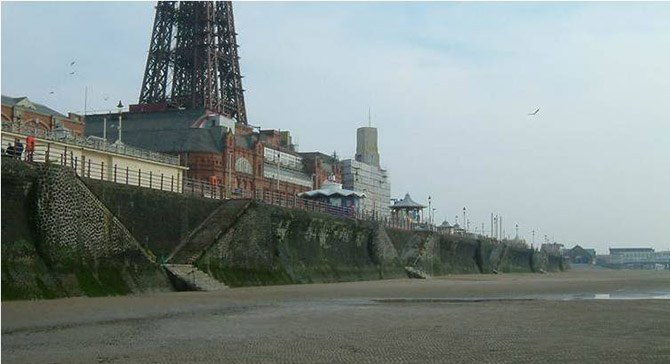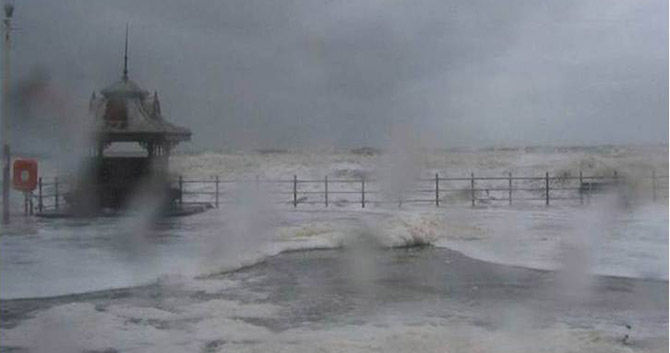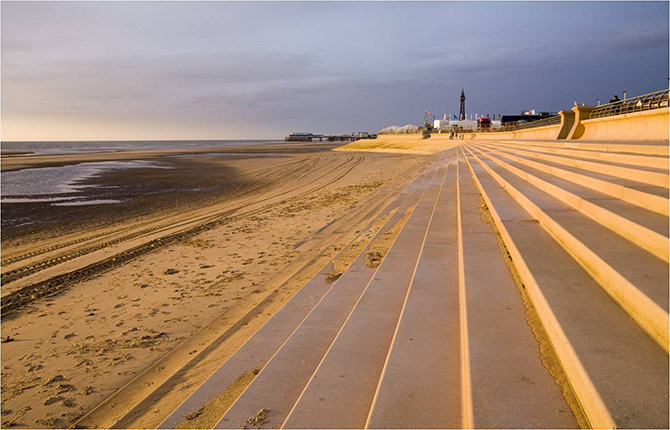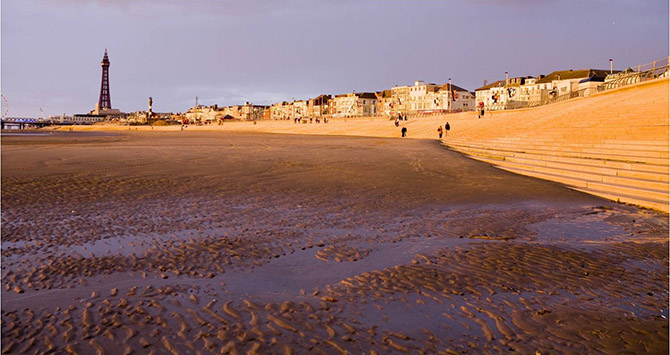Coastal resilience through biomimicry
Blackpool’s new seawall, mimicking the dunes that once protected this coast. Copyright AECOM photo by Dixi Carrillo.
The concept behind biomimicry is really quite simple. Our planet’s biological and environmental systems are the result of an ongoing 3.8-billion-year ‘research and development’ process. This has resulted in some amazing solutions to problems that human society faces as well — all tuned to work within our planet’s constraints and therefore “sustainable.” So why not learn from them?
This may seem like common sense, but we as humans have a legacy of often working against natural systems, rather than with them. This is no truer than with our relationship to the coastline. This is a place of dichotomies, often highly populated and seen as desirable by many, yet at the mercy of shifting coastal dynamics and oceans with immense power to erode land over time and destroy human developments in an instant. The response has often been to construct high seawalls, built in an attempt to do battle with the sea. But in a time of rising sea levels and increased frequency of major storms, the long-term resilience of such an approach is starting to be questioned, as even the largest of manmade structures are starting to fail.
By contrast, biological coastline protection often shows surprising resilience to ocean forces. From the mangroves of the Asiatic Pacific to the sand dune grasses of the north Atlantic, these landscapes shield the hinterland through a more responsive give and take while maintaining their system’s overall integrity. The UK’s sand dunes are a great example of this, able to take the full force of the north Atlantic’s winter storms. The extensive root systems of the Marram Grass trap sand blown by the wind, gradually building high mounds over time. During storm events the broad sloped surfaces of the dunes help dissipate wave energy in a far more effective way than a vertical wall would do, spreading the impact across a wide, shallow area rather than concentrating it at one point.
Battling against coastal dynamics. Blackpool’s old Victorian seawall at low tide and being overtopped during a winter storm.
The resort town of Blackpool on the UK’s northwest coast is a classic example of what can go wrong when you work against natural coastline dynamics. It was built on a sand dune, which, as the town expanded, the Victorians replaced with a monumental 10-meter/30-foot-high seawall. This severed the town from its main asset, its beach, and as competition grew from continental European destinations, Blackpool fell into economic decline. To make matters worse, by the early 2000s the seawall was failing to hold back increasingly stormy winter seas, which began to flood the town.
The solution has been to learn from the dunes. The high wall has been replaced with a gently sloping set of steps stretching the length of the town, mimicking the incline of sand dunes to dissipate wave energy. Each step aids in this process, acting as a mini wave wall to break up the force of the waves incrementally. Unlike a conventional approach it intentionally allows a degree of inundation during severe winter storms. During these events the promenade at the top of the stairs becomes flooded. The floodwaters are contained by a low wall sculpted to serve as public seating at all other times. This approach has allowed the structure as a whole to be lower, enabling strong connections between town and beach during summer months.
The synthetic dune. Merging coastal dynamics, beach access and the town’s protection needs. Copyright AECOM photo by Dixi Carrillo.
For the first time in a century, tourists can walk directly from the promenade into the sea, with the steps colored to match the famous golden sand. The design was informed by extensive wave tank modeling to understand local coastal dynamics and most effectively mold the final form of the serpentine steps. Today sand can be seen migrating up and down the steps during the course of a year, following seasonal coastal dynamics, the town now protected by its monumental, synthetic dune. What can also be seen is the functional, aesthetic, and economic value of designing in harmony with nature.
 James Haig Streeter (james.haigstreeter@aecom.com) is a principal in AECOM’s global Landscape Architecture practice and co-led the design of Blackpool’s coastal protection.
James Haig Streeter (james.haigstreeter@aecom.com) is a principal in AECOM’s global Landscape Architecture practice and co-led the design of Blackpool’s coastal protection.










